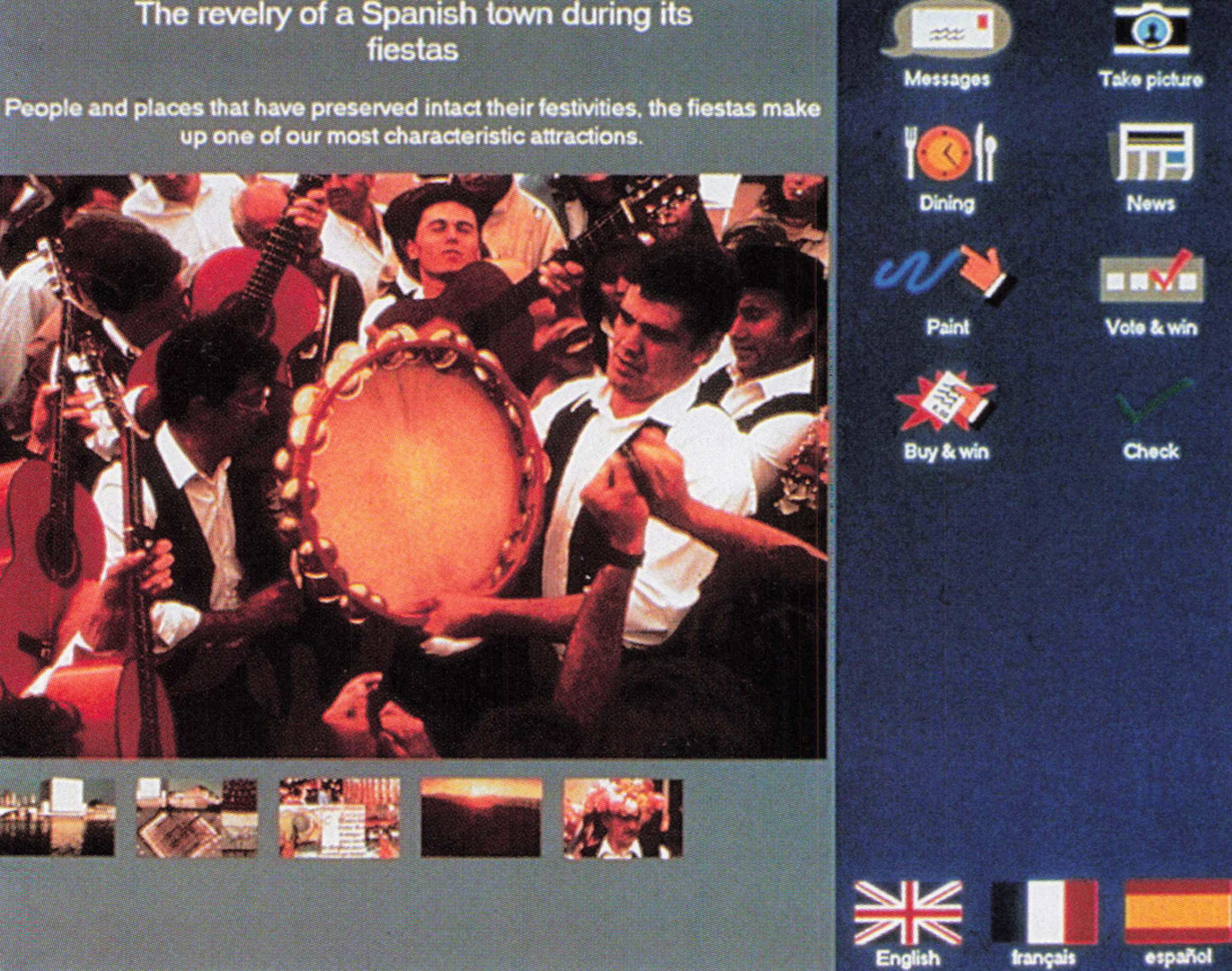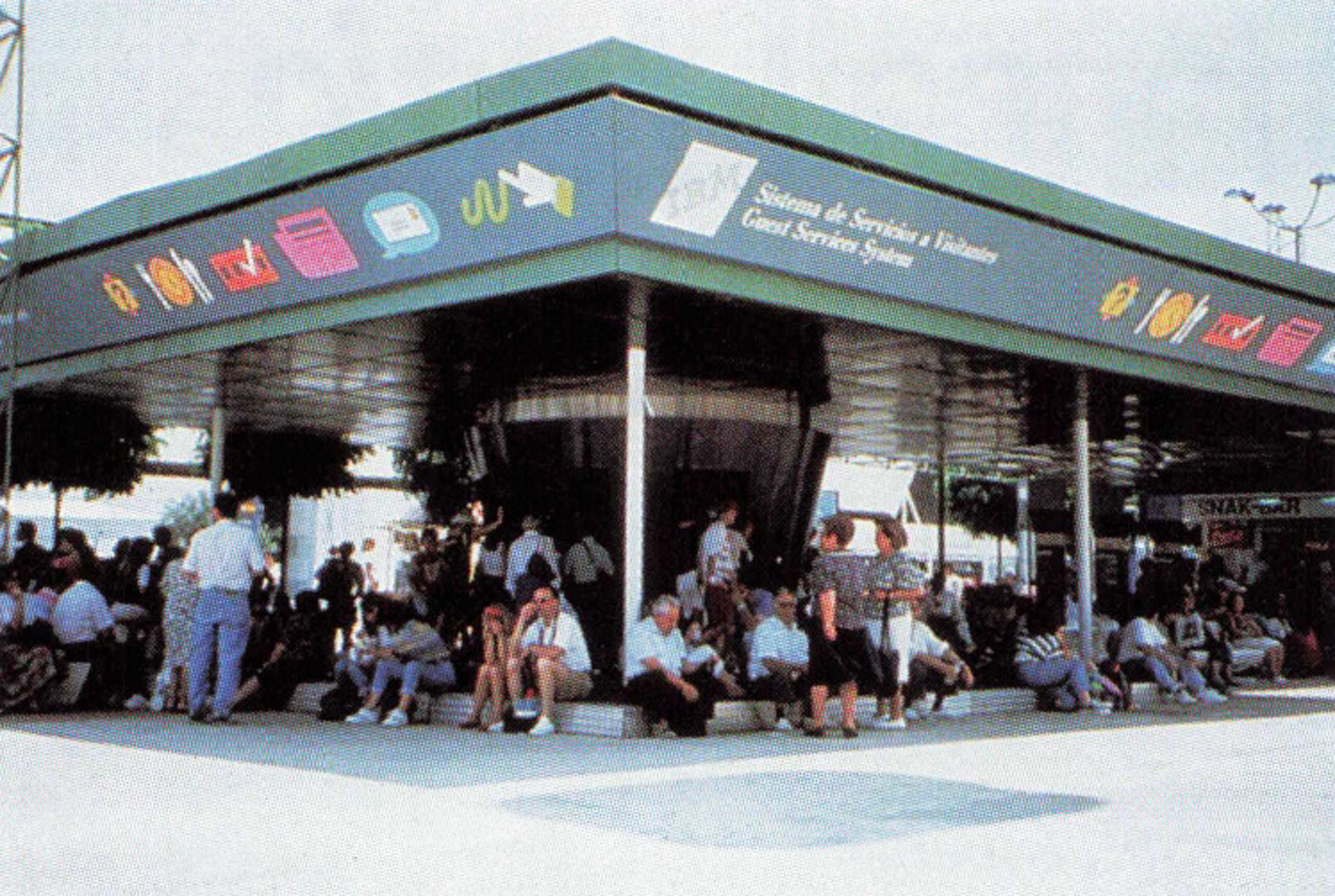“The IBM Guest Services System at EXPO ’92” by Jones
Conference:
Experience Type(s):
Entry Number: 07
Title:
- The IBM Guest Services System at EXPO '92
Program Title:
- Designing Technology
Organizer(s)/Presenter(s):
Collaborator(s):
Description:
Visitors to EXPO ’92, the recent world’s fair in Seville, Spain, enjoyed a novel collection of multimedia applications at any of 231 networked touchscreens of the IBM Guest Services System. Visitors found pavillion locations, stories about the participating countries, and the daily news, all in a colorful pictorial style in Spanish, English and French. They also used their magnetically encoded entry tickets to make restaurant reservations, take their pictures, send voice-and-image messages, and save finger paintings. As the official information service provider for EXPO ’92, IBM defined, developed, installed, and operated this unique public transaction system.
Goals
The primary goal of the Guest Services System was to enhance the quality of a guest’s visit to EXPO ’92. To meet this goal, the system clearly had to be easy to use and quick to respond. It had be fun and attractive to compete with the diversions of a world’s fair. And it had to survive the severities of the Sevillan weather and heavy usage. The design team wanted to make use of an interconnected network of kiosks to allow EXPO guests to not just passively read information, but to actively create information.
Team
The Interactive Transaction Systems (ITS) group at IBM Research believed it was important to bring a variety of skills to the project from its inception. Computer scientists, psychologists, engineers, programmers, and graphic designers all contributed to the design and implementation. The collaboration extended beyond the research group, with the involvement of IBM Spain, EXPO ’92, third-party suppliers, the pavilion participants, and the EXPO visitors themselves.
Process
The design process began by defining a high risk vision: the selection of information and services that would appeal to millions of fair-goers. There were some who counseled that our ambition overreached possibility. To ensure the vision became reality, the design team worked closely as equal partners to iteratively evolve each detail of the system: content design and creation, services design, user interface design and testing, hardware specifications, networking, and system management. The evolving system prototype was placed on the EXPO site where pre-opening tourists could try it out while team members discretely took notes. These important observations were fed back into the design process.
The team shared the work of coordinating efforts with EXPO, restaurants, and pavilion staff, photographers, news providers, and maintenance and operations crews. Even the 33 kiosk structures that housed the guest stations and the bright signage that tied the kiosks together in the minds of the visitors benefited from this group approach. Each team member had primary responsibility for certain aspects of the project, but each one could be counted on to jump in anywhere at any time they were needed.
Results
The Guest Services System was, by any measure, a resounding success. Between ten and 15 million visitors were estimated to have used the system. The operation of the system was impressive, registering over 99% availability during the six months of operation, 19 hours each day, every day. At a typical week at EXPO, guests saved 126,000 video images, 63,000 finger paintings, and sent 42,000 multimedia messages. They touched the screens 92,000,000 times.
Equipment
Each of the 33 Guest Services System kiosks on the EXPO site held seven guest stations. Each station was comprised of a 33 Hertz PS/2 Model 95 with 16 MBytes of memory and 1.2 GBytes of storage, linked to a server via token ring. The entire kiosk was linked to the Central Kiosk Control by fiber cable, where another 66xx PS/2s provided storage of visitors’ finger paintings, video images, messages, and restaurant reservations and monitored the status and activity of each guest station.
An IBM 19-inch 6091 display (1280 x 1024 x 256 colors) with a touch overlay was the primary interaction device. Each station also featured a video camera and lights, microphone and speakers, and ticket readers.
Designing Technology Presentation
The demonstration model in the designing technology show is a specially adapted stand-alone version of the final Seville system. It holds nearly half of the pavilion stories, and includes a new ‘behind-the-scenes’ story on the making of the system. We are also showing a 15-minute documentary video with highlights of visitors enjoying the Guest Services System.
We want to acknowledge the contributions made to this project by IBM Spain, EXPO ’92 staff, the Guest Services System News Team, the 100 EXPO international participants who supplied stories about their pavilions, Associate Designers (kiosk design), Mapasa (kiosk signage), and the millions of fair-goers who used the system.
Additional Images:
- 1993 E-Tech: Jones_The IBM Guest Services System at EXPO ’92







